
(Photos: J. Maus/BikePortland)
Division Street east of 82nd is one of the deadliest part of our entire transportation network. Designed exclusively around the use of private motorized vehicles, it’s a vast, nine-lane behemoth full of speeding, multi-ton vehicles driven by many people without regard to laws or the safety of others. It also happens to be directly adjacent to places where a growing number of Portlanders live, work and play.
“We’re here today because this street design doesn’t work.”
— Jessica Engelman, Bike Loud PDX
But for a few hours on Saturday afternoon everything was different. People drove slowly and there was space to talk and walk and ride a bike without worry of being run over.
After two more people were killed on Wednesday night, volunteer activists with Bike Loud PDX organized a “public takeover” of the street. A few dozen people braved the weather in an effort to narrow the street and slow people down — their bodies buttressed against Division’s traffic by fellow volunteers, hay bales, yellow caution tape and a few traffic cones.
Jessica Engelman led the event. “We’re here today,” she shared as everyone who gathered around her in a circle on the southwest corner of SE 82nd and Division, “Because this street design doesn’t work.” Engelman said she’s tired of hearing about personal responsibility of road users and wants the Portland Bureau of Transportation to reconfigure the lanes on the street. Engelman and other activists want the outer lanes of Division repurposed for something safer and more efficient like dedicated bus service and a bike lane. PBOT has already done some redesign of Division west of 82nd (adding a bike lane between 82nd and 60th) and Engelman demanded of the city that, “What you do over there [pointing west], you need to do here. It’s an equity issue.”
About half of all of Portland’s traffic fatalities happen east of Portland where wide streets encourage dangerous behaviors and options like biking and walking are far less attractive due to a lack of safe infrastructure. Division is a particularly glaring example. This year alone five people have died in traffic crashes while using Division (four people walking and one person driving). In addition to those fatalities there have been at least three serious injury crashes. Seven of these collisions happened on a two-mile stretch between 124th and 156th.
These reported collisions are in addition to the hundreds of daily aggressions suffered by everyone who uses the street.
Kristi Finney has seen more than her share of tragedy on Division. In August 2011 her son Dustin was biking near 87th when reckless drunk driver struck and killed him. Finney addressed the crowd yesterday while standing just a few blocks from where his body came to rest, “Thank you for being here to make this street safer when the people who are supposed to be doing it are not,” she said.
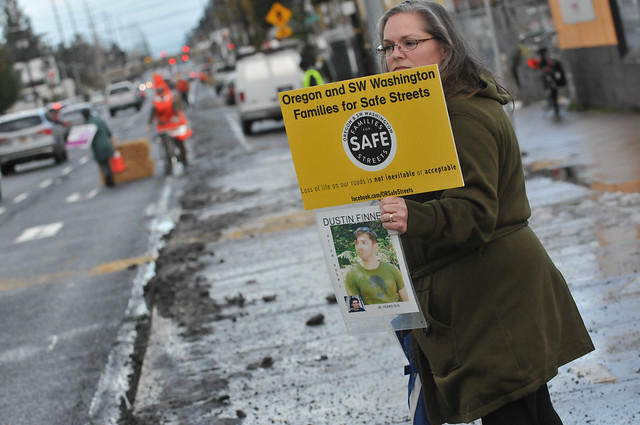
Then, looking out into the sea of people driving cars behind her, Finney added, “I wish they understood you are here to save their lives too.”
Since her son was killed Finney has devoted her life to safe streets. She’s a founding member of Oregon and SW Washington Families for Safe Streets (Facebook) and was one of nine bereaved family members to sign a letter this week demanding immediate action on Division from the City of Portland.
Advertisement
Local resident Ken Eucker heard about the event online and showed up to offer his support. “Every time there’s a death I’m quite affected by it,” he shared with me. “I’m hoping this event builds more awareness.” Eucker was wearing one of the rubber wrist bands with the words “Rest in Power” on it that were given out by Fallon Smart’s family after the 16-year-old was run down by a man driving 60 mph on SE Hawthorne last fall. “I feel like like if I don’t keep coming out this [feeling of concern] will fade like the ink on my wristband.”
After brief instructions from Engelman, people split into groups. Some were assigned hay bale duty, others volunteered to be on “PR duty” which meant they held signs and smiled-and-waved at passing traffic.
No one was quite sure how this relatively small group would tame traffic on such a busy arterial. They got a little reassurance by the presence of a Portland Police Bureau vehicle that was clearly circling the intersection (turns out Engelman notified PBOT and the PPB prior to the event and the patrol car was sent to make sure everyone stayed safe).
The group set up the first station at 84th. While a dozen or so people held signs saying things like “20 is plenty” and “No more deaths on Division,” others hauled large bales of hay from a van. The bales were stacked two-high in the outer standard vehicle lane (to the left of the bike lane and parking lane). The idea was to have the hay bales act as traffic calming and a barrier so that people in cars would merge into one lane. They were placed every block or so on both sides of the street between 84th and 90th. To prevent people from plowing through the hay bales with their cars, volunteers stood in front of them holding signs while smiling and waving.

It worked.
Almost immediately people merged their cars and trucks into one lane of traffic and slowed way down. The other lanes opened up for people walking and biking (the existing bike lane was not safe to ride in due to slush and ice).
We’re taught to be afraid of cars, especially on big nasty streets like Division. Engineers are afraid to slow them down or reduce their capacity, vulnerable road users try to avoid them at all costs. But we learned on Saturday that managing this public menace can be as easy as herding sheep. With just a few hay bales and homemade signs, people fell dutifully into line. There were a few people who yelled and/or tried to speed around the bales, but overall everyone seemed fine with the new arrangement.
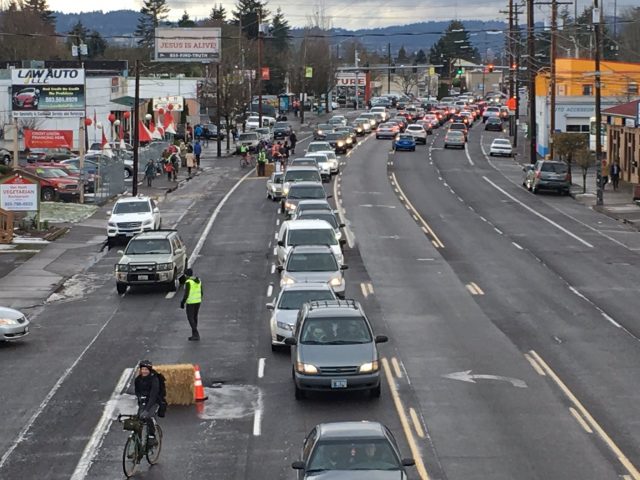
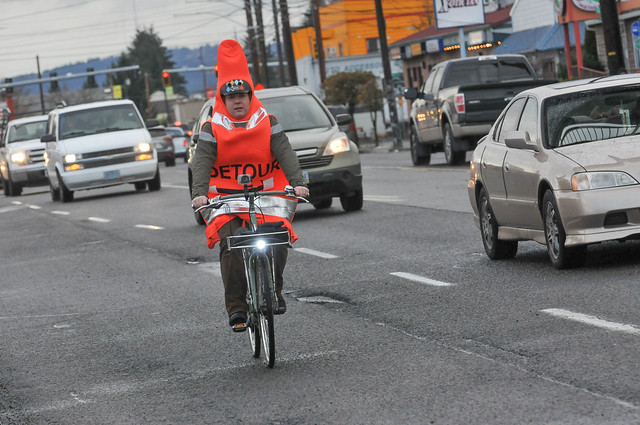
In an interview after the event, Engelman said she planned to keep the bales on the street indefinitely. “We will take them down if we have assurance from PBOT that this street will be addressed.” She said the event wasn’t a one-off demonstration but rather, “An emergency traffic-calming measure not just for a few hours but until the problem goes away.”
It was reported on Twitter last night that the City of Portland already removed the bales.
It’s not likely the activists will go away as easily.
“PBOT has our backs to the wall and we want them to know we’re serious,” Engelman said. “This isn’t the type of action that Bike Loud typically does, but this is not a typical situation.”
Further reading: Twitter threads by two people who were at the event: @_P_J and @twjpdx23; coverage by The Oregonian.
— Jonathan Maus, (503) 706-8804 – jonathan@bikeportland.org
BikePortland is supported by the community (that means you!). Please become a subscriber or make a donation today.


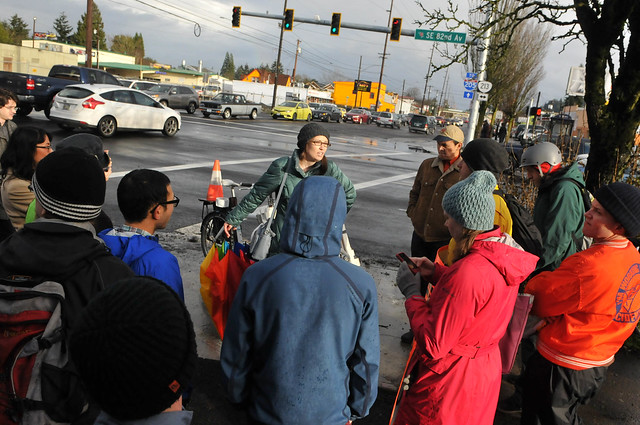
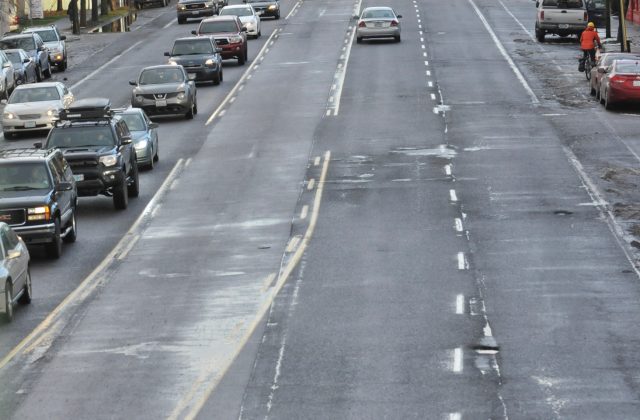

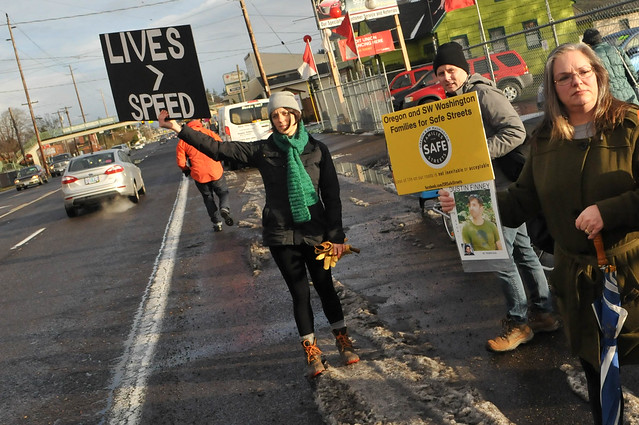


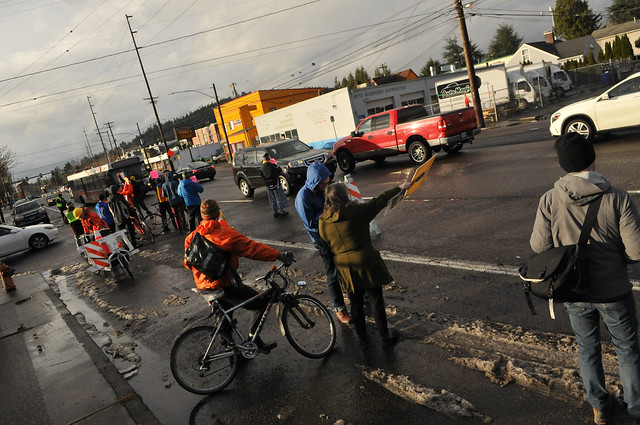
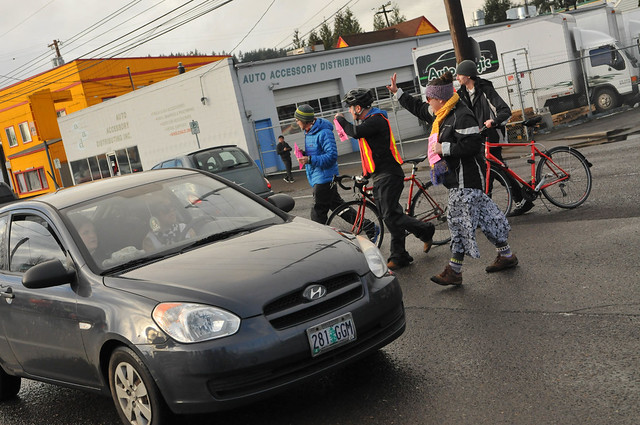
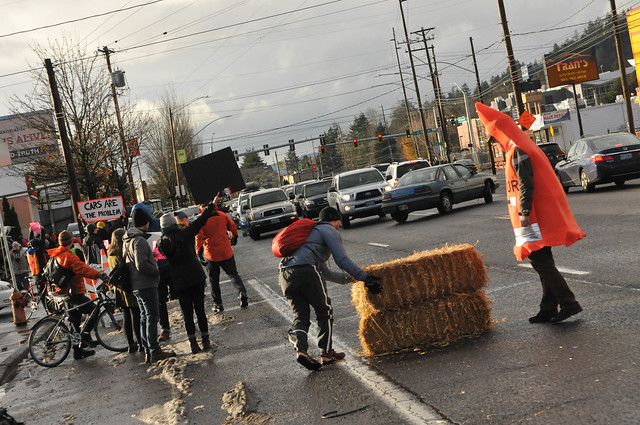
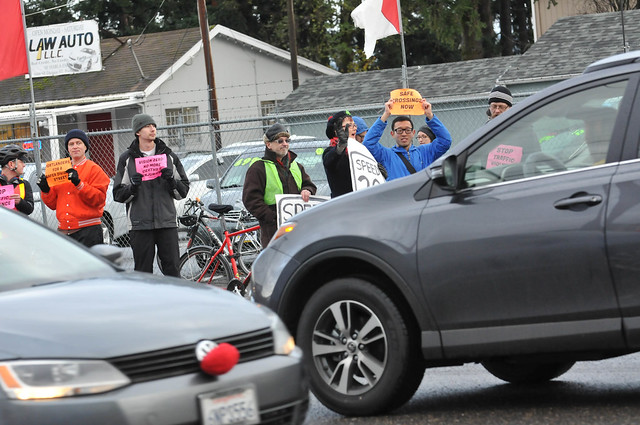
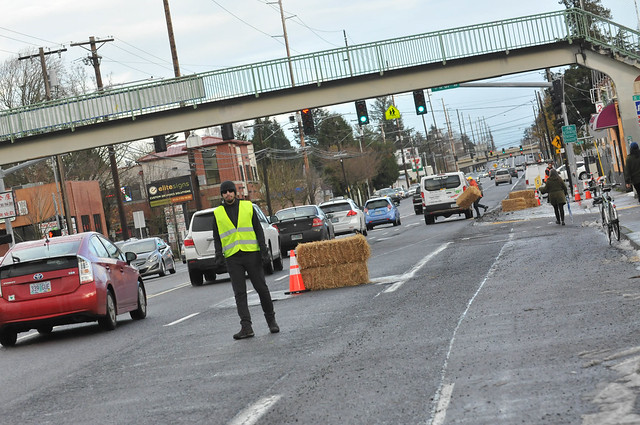
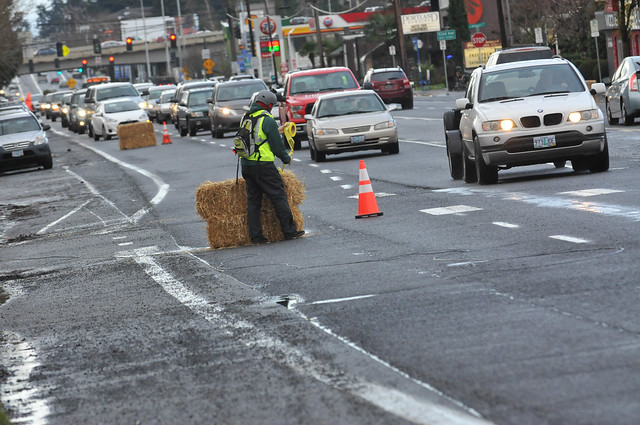
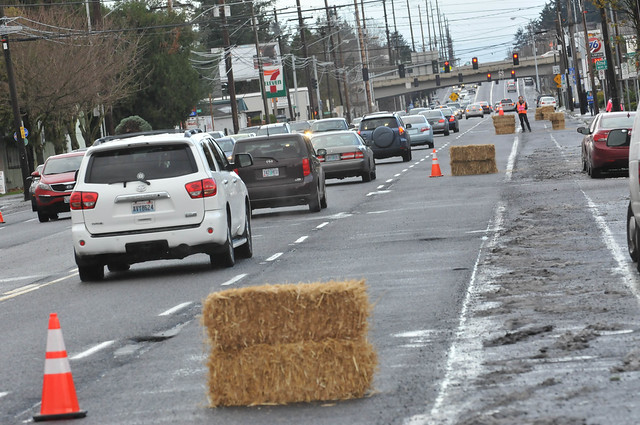
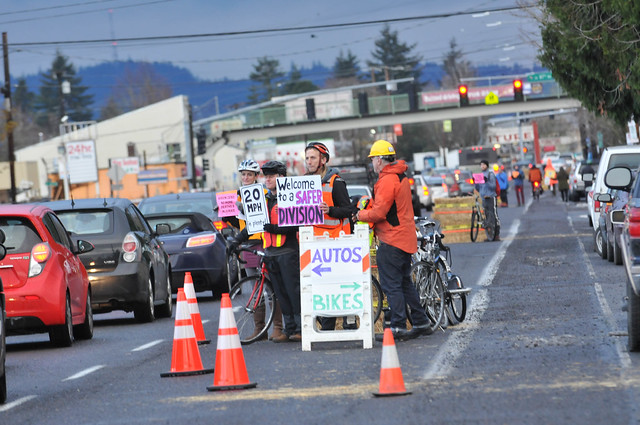
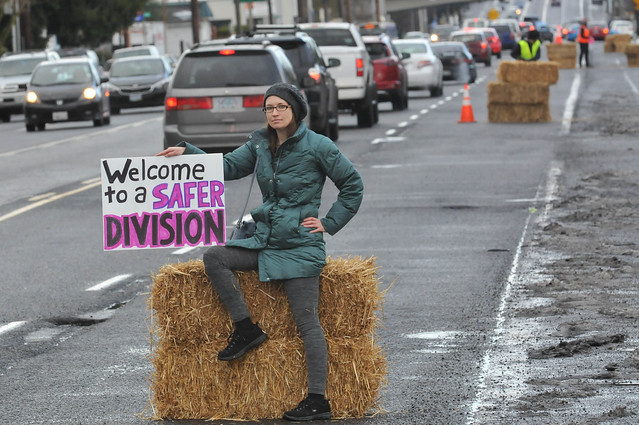

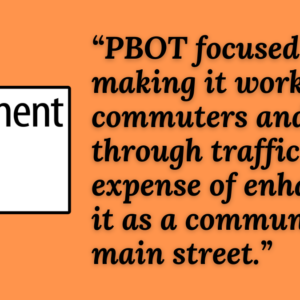

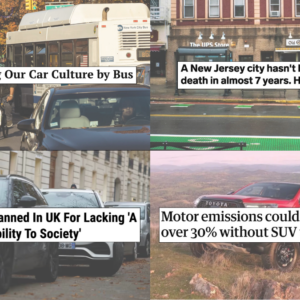
Thanks for reading.
BikePortland has served this community with independent community journalism since 2005. We rely on subscriptions from readers like you to survive. Your financial support is vital in keeping this valuable resource alive and well.
Please subscribe today to strengthen and expand our work.
Thank you, thank you, thank you!
Also very much worth noting is that this is the first time one of these tactical urbanism-type actions has taken place east of 82nd. In the past, Bike Loud and other activists have been criticized from within the transportation reform community for being too focused on inner neighborhoods.
Big “THANK YOU” to Bike Loud PDX.
I love living in a city with such thoughtful activists fighting to make our streets safer.
Pictures of the street with cars backed up behind up behind the hay bale barrier in the outside lane, show that the action aggravated traffic congestion. The lane closure contributed to the creation of a traffic jam.
By the way…what time of day did this demonstration take place? This time of year, by the level of daylight apparent, and with motor vehicle headlights not on, it looks like before 4pm. That’s not even a peak commute hour. Congestion from lane closure would likely be worse during peak commute hours.
Means other than lane closure, to bring down top mph posted speeds would be a great starting point towards having Division become more functional for walking and biking. 20mph or even 25 mph, might actually be just fine for enabling traffic flow and still provide for safe walking and biking.
It could be interesting see what kind of motor vehicle backup might occur from a lane closure on Division on some of the lowest road use hours of the day. Not sure what hours that may be; maybe 10am-11am…or 7pm -8pm. Or, from10pm–2am…hours during which there may be far less motor vehicle traffic on the road compared to the am/pm commute. And its during those hours that the greatest number of motor vehicles exceeding posted top speeds, occurs.
Ha! “aggravated congestion” lol.
Congestion could definitely stand to be aggravated on a regular basis. Maybe if we make congestion grumpy enough, it will go away.
If some were slightly inconvenienced (though I doubt there was much actual impact on trip times), that’s okay compared to the cost of people’s lives.
I see the humor in your remarks, and I think it’s good to have a sense of humor to some extent, about traffic congestion…but some serious thinking also is needed to resolve the problem of being able to adequately support safe and efficient flow of motor vehicles driven by people using the street for travel during peak road use hours. In addition to safe and efficient use of the street by people traveling by modes other than foot and bike; walking, biking, etc
What are some more details about the traffic during the demonstration? Such as…what was the average motor vehicle speed some distance back from the hay bale barricade during merge transition from two lanes to one…and what was the average vehicle speed after the barricades? And also, did the barricades result in any stop and go traffic?
Not having been out there myself to see just how much traffic this section of Division has daily, I can’t say for certain, but impression I’m getting from pics and people’s comments, is that the street has a lot of traffic, that may already be routinely resulting in traffic congestion. It’s that congestion to which I was referring when I noted the demonstration may have ‘aggravated’ the congestion, rather than to the patience and frustration of people driving the street. But of course, maybe you know this.
Other examples throughout the city give some idea of what can happen when peak traffic flow isn’t effectively supported. Cut-throughs are just one of the bad things that can result.
efficiency for machine movement and safety for humans are at complete odds with one another. please do not conflate the two.
just like with power tools, airline travel, and crosswalks near the newer MAX stations, safety means inconvenience.
You have to look at the bigger picture to figure out the actual impact on convenience and efficiency. Traffic speeds don’t matter if everyone is racing to wait together at a red light, which is generally the case and definitely wasteful. Someone driving two blocks and back in the neighborhood might have been thoroughly inconvenienced (why not ride a bike?) The people killed on this street (and their families) have been infinitely inconvenienced.
Heavy traffic needs to behave appropriately. It’s inconvenient (and inefficient) to be unable to easily and safely cross the street due to a river of hazardous traffic. Cancer and obesity might also be inconvenient.
The actual result of making driving less convenient than biking or walking for short trips is to make everything more efficient by removing congestion and parking. Maybe transit needs to solve the last-mile problem first.
I don’t see a way to resolve the current inequitable situation without impeding traffic flow and making it more frustrating and inconvenient to drive a car. Right now, it’s so frustrating and inconvenient to get around any other way that most people favor the car hands down over everything else. We now have so many people living in Portland with many, many more on the way that ‘ensuring smooth flow of traffic’ is not a game we’re going to be able to win. At some point, there will be so many cars that it will be impossible to ensure smooth flow of traffic – and there will, at that point, be no palatable alternative, because no one wants to walk, ride a bike or take a bus around that suffocating clot of smoggy, dangerous vehicles. If we want a livable city, we need to get people out of their cars, and as long as driving is kept convenient and comfortable and prioritized over every other mode of transportation or use of public space, that’s not going to happen.
So the solution to inconvenient public transportation is to degrade the alternatives to the point where transit looks good? No thank you.
One alternative would be to not make downtown be the primary destination of everyone. We need to develop at least one other city core, perhaps at Gateway, and start incentivizing jobs and housing there.
Keep everyone in a car and the transportation system is eventually going to grind to a halt anyway. Better to get there with a smooth landing and a workable plan.
As far as creating more downtowns, how did that work for SoCal in the 1950’s?
Hi HK – I wouldn’t suggest degrading all the other alternatives, just car travel – and that only because its comfort and convenience comes at the expense of everything else. Freeing up money and space to make transit, walking and biking more convenient and requiring cleaner air and safer, cleaner, more ubiquitous accommodations for other road users will automatically degrade the motorist experience.
I don’t think revitalizing the burbs is going to be enough to make a difference – the sheer number of cars needs to come down. Car experience needs to be degraded and other modes improved outside the city center as well.
the point you seem to be missing here is that traffic needs to be slowed down. speed kills, and there has been a lot of killing on this stretch recently. think of the cars on an unimpeded division st as the particles in a warm mass of gas. if we slow them down we naturally increase their density, allowing the same mass to fit in a smaller space. the resulting mass is easier to control and less dangerous. safety is more important than speed. safety is more important than inconvenience. people will be whiny when changes are made, but as the story shows, most won’t mind and will comply.
I’ll have to remember that phrase of “aggravated congestion” for future editions of Cards Against Humanity. You can’t write humor of that caliber without the genuine delusion behind it that props it up.
Something else I should have brought up, and I think we all should be thinking about with regards to questions about why collisions involving people on foot and people driving may be happening:
What time of day have the collisions of late, involving people on foot and motor vehicles, been happening, for example…the two on Division last Tuesday? Answer, in the case of those two, was 7pm and 9pm. Those collisions did not happen during commute hours when traffic on Division would likely be heaviest, and when the multiple lanes of travel in each direction would be most needed to ease traffic congestion.
http://www.oregonlive.com/portland/index.ssf/2016/12/police_id_pedestrian_driving_i.html
Outside of commute hours, when fewer people are on the road with motor vehicles, meaning less motor vehicle related congestion…also is the time I think may be when people inclined to exceed the speed limit are doing so.
I believe the tendency…where motor vehicle traffic is heavy and all through travel lanes on thoroughfares in each direction are filled to capacity…is for motor vehicle mph speeds as a whole to be little over the posted speed, say 5 mph, and often much slower during times of heavy congestion such as during commute hours.
I was surprised by the lack of congestion. Even an hour into the action the westbound traffic was only backed up about one block. The eastbound traffic was more congested largely due to the large number of people holding signs at the lane merge. I would guess that congestion would be a bit worse on a weekday rush hour but as past road diets have shown, concerns are often overblown and large backups don’t really seem to materialize from dropping the extra lanes.
Either way a human life outweighs a minor traffic slowdown in my book.
There usually isn’t as much traffic on Division between 82nd and I-205, with traffic getting on I-205, as there is between I-205 and 181st, where Division is more of an expressway and moving much faster. In general, the peak period is actually often on Saturdays in auto-dependent areas, with folks out shopping.
Reducing the number of lanes in each direction used to great extent for motor vehicle travel, reduces road capacity supporting that form of travel, rather than reduce the mph speed at which motor vehicles travel.
If the objective is safer road use for all road users, through motor vehicles being used at above no more than a specific mph speed, then set the desired speed, and hold road users to no more than that speed.
Saturday mid afternoon, seems to have been when the demonstrators chose to put out the straw bales ( I hope it was straw, and not hay, which is food for livestock.). Maybe choosing a weekday rush hour would have made a much stronger demonstration of the effect of blocking one of the main lanes of travel on this section of Division.
I’m wondering how many, if any, of the collisions having occurred on this street, involving people driving motor vehicles and people on foot, with injury and death of the latter…occurred during rush hour times of the day, due in some way to this road having more than one main lane in each direction. Maybe someone else reading here, has some ideas about that.
“but as past road diets have shown, concerns are often overblown and large backups don’t really seem to materialize from dropping the extra lanes.”
That’s because PBOT has specifically picked locations where they don’t anticipate there will be major impacts. Selection bias.
I would say that the presence of people slowed down traffic more than the lane closure did…
What’s the opposite of ‘induced demand’? I think that’s the goal.
Is this also caused by hay bales? -> https://www.google.com/maps/@45.5243231,-122.6650861,13.75z/data=!5m1!1e1
I ventured over to the comments section of the Oregonian article about this event and, well, I regretted it.
You will notice that as we get deeper into this conversation about what streets are for and how they should be updated and redesigned, people’s reactions will become more and more aggressive. I’ve noticed that as I’ve made my tone more directly about dangerous drivers and dangerous roads and a major change to the status quo – I get a lot more angry emails and comments. It’s all part of the process. IMO it’s a good sign that we are moving the conversation forward. Powerful status quo never changes without people getting unhinged a bit.
Dangerous drivers, dangerous roads & dangerous leadership decisions. The whole system is wrong, and it’s why I hesitate to support just the street redesign part. Paint is cheap, and there are many more variables that are arguably more sustainable, such as changing the laws and regulations that support the mess we’re in.
Ultimately, politicians either hired the people that brought us these problems, or were the problem in the first place. It’s important to vote, and do it every year, and support candidates who understand the problems and are willing to do the work the change the system. Our current crop does not care, or doesn’t even understand the problem.
For example, did you know that the state laws raising the drinking age to 21 were part of a federal highway funding scheme? Why? Because decades ago prohibitionists offered an easy fix to a sociological problem, and it endures because it was written into law. It’s absurd to think teenagers – or anyone else – stopped drinking and driving all of a sudden, because they never stopped. Did those same politicians who raised the drinking age to 21 also include provisions to add access to alternative modes of transportation to reduce the need to drive in the first place? No, because prohibitionists and morality police are not public policy experts.
When I was in the Army (I was discharged in 2013), I was stationed for several years in Germany. You cannot find a city in Germany that does not have a comprehensive public transportation system, including rail, bus, tram, bicycle and pedestrian routes, etc., and it doesn’t matter what political party is in charge there, because these issues are not matters of debate.
Portland, if you want to be a city, you need to start acting like one.
Traffic congestion problems have been decades in the making, and they’re far from due simply to a bunch of politicians some people think whom don’t care about or understand the problems or their consequences. We, people as society today, have these super thoroughfares, like Division in Portland, or the Beav-Hillsdale or Canyon in Beaverton…because that’s what the people wanted. They spoke, and the bureaucrats produced.
Out in Beaverton, we’ve got ugly carbon copy versions of the multiple lane Division St being discussed here. Used to be a two lane road, as was Division at one time. What percent of the people in outer southeast Portland surrounding this section of Division St, really would favor reducing from two to just one, the number of main lanes in each direction? I wonder.
Interesting thing for people convinced that Division’s multiple lanes of traffic are a primary cause of collisions fatal to people on foot on that street…may be to take a look at Canyon Rd or Beav-Hillsdale in the Beav, between Raleigh Hills, West Slope, and Cedar Hills Blvd. As I said earlier: similarly laned roads. Yet, while I’m not sure because I’ve not checked, I don’t think those roads are experiencing the kinds of fatalities that Division is. Possible difference? Lots of intersection with full traffic light signaling…and increasingly…speed violation cameras.
people are crashing and dying over there on those roads too, and some are reported here… it will get just as bad as Division as more infill is created and more people are annoyed at congestion…
right now not as many people walk over there because it’s way more hostile than Division… as they put in apartments and sidewalks more people will get killed if nothing is done to tame the road…
One big difference is that hardly anybody walks or bikes on the roads out here. They’ve all been successfully scared off.
This is a huge component. And income has a role of course, which is part of why there are many who are focused on the (lack of) parity the outer east side sees in terms of efforts/budgets/etc.
As a Bike commuter that rides in Beaverton, this is true. It is SCARY to ride in Beaverton. The drivers seem more aggressive out there. I have to cross six main roads out there (including TV Highway which is just a disaster) and every time I get home (or to work), I’m like, “Hey, I made it!”
You are correct sir.
Never read those. You will want to move away.
I don’t understand, there are bike lanes east of 82nd on Division. The real problem is heading west on Division because the bike lane ENDS just past PCC. There isn’t a bike lane in front of Atkinson Elementary School but plenty of opportunities to get hit by a car while someone is picking up their child after school.
Someone being killed by a drunk driver has nothing to do with the speed of traffic and nothing to do with the (already existing) bike infrastructure.
All these misdirected attempts at “traffic calming” really hinder the progress of bicycles being accepted as a legitimate form of transit. It just makes cyclists seem like a nuisance and makes us look like we think we’re entitled. Bike Privilege is just as bad as the kind of privilege that begins with a W.
Let’s talk about car privilege. Maybe the entitlement and nuisance is greater with the illegitimate (or at least poorly trained) operators of big heavy things that kill people (generally as a result of breaking laws which are generally ignored.) Against that backdrop, what does a person on a bike have to do to “look like we think we’re entitled” to the thing we are actually in fact entitled to? Perhaps we should not dare ride at all? “Had it coming, swimming with the sharks and all that, it’s their own fault at the end of the day.” yeah?
I agree with you, I guess you didn’t catch that I commute by bike. I ride this stretch of SE Division from 122nd to 12th. The dangerous part is west of 82nd where the bike lane ends, and the gentrification of Division St. starts. No bike lane, super narrow, which impatient motorists trying to park so they can shop, eat, and drink at all the yupster businesses.
The ruling class can be ‘entitled’. What you are describing is ‘uppity’.
I think most of the entitlement comes free with the purchase of gasoline (and gasoline is pretty cheap.)
No doubt. $3 to move a 4000lb container 25 miles is a pretty good deal.
“The dangerous part is west of 82nd where the bike lane ends”
how many people have died on that section this year?
yes, it’s dangerous, but it’s not as dangerous…
Seems PCC to 60th would be the nicest with a bike lane and only one auto travel lane in each direction. But all the way to 12th… Yikes. Why not jump over to Clinton or Lincoln? Seems like those would be faster and much more pleasant that trying to filter trough traffic in that popular area of division.
There is indeed a bike lane on Division that does not end at PCC but continues to 60th. It DOES end at 60th, very awkwardly, I might add. I work at that campus and often commute by bike. The lane makes it a very nice commute home…until 60th. Then I hop over to Lincoln, which makes a lot more sense than Division, esp. with all the new apt construction between 50th and 60oth. Yuck.
At 60th you then jog over to Lincoln (or to Clinton). Not every street should be ridden on. Especially with Clinton and Lincoln being so close, safe and dedicated to biking.
I would like to be able to ride my bike safely on inner Division. Currently, I cannot.
You never will. Inner Division is safe to ride on now (especially heading downtown); the only way to make it safer would be to close it to auto traffic altogether (perhaps diverting it onto Clinton?)
It sounds like you haven’t bothered to read about this protest or why it took place. It wasn’t about bikes. Outer Division is deadly for all road users, but especially people on foot. And the traffic-calming measures enacted on inner Division prove that the city could have a street that is safer for vulnerable road users while also having negligible impact on travel time for drivers.
To your next point: “privilege” isn’t some sort of boogeyman that automatically makes something bad. Yes, us protesters are privileged. We’re privileged to be able to afford a bunch of hay bales, signs, and cones that we’ll never get back. We’re privileged to not have to work on weekends. We’re privileged to not expect police violence in the way that people of color in other cities do.
We use that privilege to be a voice for those that are underrepresented in our city, such as the people that have to live near outer Division. Many of those people expressed their appreciation for our efforts, and their frustration at not having the calmer, cleaner Division street that the wealthier inner neighborhoods get to enjoy.
Well at least you recognize your privilege.
Noblesse Oblige!
Take another look at where the deaths and serious injuries are happening on Division. They happen with alarming frequency in East Portland. Why the disparity if speed of flow doesn’t affect safety?
what does this have to do with bicycles? we’re talking about PEOPLE getting KILLED…
Not all the injuries and deaths are people travelling along division, many of them have been people trying to cross a street that is too wide with too high of speeds.
Those tiny door-zone bike lanes are suicide. I will ride on the sidewalk when I need to get out that way. We should remove the sparsely-used parking lanes to convert them to protected cycleways.
I hope you ride slowly so as to not endanger pedestrians.
Skid, sounds like you have plenty to learn on this topic. Your assumptions above are *all* mistaken/misunformed. Stick around and get more knowledgeable, then add your better-informed voice to the discussion.
I’ve been riding bicycles in this city and in Beaverton, Aloha, and Hillsboro since 2002. I’ve volunteered at CCC for years and done my fair share of bike advocacy. Most recently I rode in the protest ride on SE Clinton so you’re welcome for the changes made to keep cars on Division from using a Bikeway as a shortcut. Sorry but lately bike advocacy has veered off into absurdity. Blocking a lane on a section of street that has a bike lane? Expecting a major thoroughfare to have a speed limit of 20 MPH? I’ve done long distance riding on the Pacific Coast Highway with tandem trucks buzzing me at 70mph….
You seem to think this is all about the presence or absence of a bike lane.
This doesn’t have to do with bike lanes.
I see your point. I also think the group has done something that takes a lot of guts. Safety should always be the priority of design. I also think that our ultimate goal for a design would be something akin to this boulevard in the Netherlands:
https://www.youtube.com/watch?v=xVnopw-VoXM&t=118s
However, I recognize that most people don’t care about or are unaware of road death (until they experience it first hand), and incremental improvements are often necessary. Therefore, the group may want to target specific short term objectives for this area (eg the removal of one parking lane for protected bike lanes between the I-205 MUP and 79th, and building frequent median barriers for pedestrian x-ings with red lights). With PBLs and medians comes motorist and pedestrian safety as well.
Protest rideS that is, several of the ones Brian “Sysfail” Smith organized.
“Blocking a lane on a section of street that has a bike lane? Expecting a major thoroughfare to have a speed limit of 20 MPH?”
yes, and yes… both things that need to be done…
82nd to 182nd is 5 miles.
35mph: 8.5 minutes & 5 deaths a year.
20mph: 15 minutes & ~20% reduction in risk of ped death.
I think society will somehow continue to function.
Note: 20% reduction is based on risk in event of being struck, does not include reduction in incidents themselves based on slower speeds.
Doesn’t sound too bad based on one vehicle; per PDOT the average daily traffic count on that section of SE Division is 21,566 (2013). Adding 6.5 minutes each weekday to every car trip = 607,100 hours a year – to potentially save 1 life.
You do make a good point that there are real impacts that should be weighed. I’m just saying, if we’re going to weigh some impacts against others, we should weigh all the sizeable impacts. As far as I know, that has never been done for road diets (or pretty much anything related to streets).
I’m talking about including safety impacts and congestion impacts on people’s time (doing an actual analysis of how many people of those daily traffic actually were rush hour commuters in the peak direction to begin with, and of them, how many wait in traffic, how many change their commute patterns, etc), but also health impacts from potential changes in the way people travel, local air pollution impacts (could go either way – I’d be interested to know which way it goes!), greenhouse gas impacts, financial impacts if people get around in a cheaper way or choose to chain trips / carpool/ etc., the time impact of freeing up adults’ time in ferrying around kids if they can walk to school and the child development impact of giving kids greater independence, etc.
Also, the 20% reduction that Bradwagon cites looks far too low based on the sources I know of.
http://humantransport.org/sidewalks/SpeedKills.htm
Based on the studies cited by the above link, it looks like more like a 90% reduction in risk (risk of death conditional on collision goes from ~60% to ~5%). Not a 90 percentage POINT reduction, but a 90% reduction in the original risk.
“misInformed”
I was on Division Friday heading to Taboo Video and I am still surprised at the differences between Portland east and west of 82nd Avenue when I bike or drive on those streets. I am glad the protest went well. Usually I do not drive in the curb lanes on streets where there is a center turn lane since I want to have a buffer zone in case a bicyclist or pedestrian ends up in the curbside vehicular lane. I do not want to hit anyone and all the deaths have scared me a bit (as well as saddened) even to the extent I am trying not to go over 35 in 35 zones.
I also agree that biking on Division near the 59th street Dairy Queen can be gnarly depending on the time of day, but drivers seem to tolerate me dominating the lane.
What with those hay bails and potential “pipe bombs” (aka bicycles) this looks a a “Bundy Brothers” style take over of an Oregon highway!
I pray no federal or state or city workers are forced to turn back on their official rounds by the congestions and go home…;-)*
[*I assume any jury of peers in Oregon would come come down much much harder on this unarmed take over of a public roadway facility versus the recent armed “borrowing” [?!} of government land and buildings at the refuge.
We’re just never going to live that thing down.
Wouldn’t be the first time Oregon made it into “News of the Weird”…
https://en.wikipedia.org/wiki/1984_Rajneeshee_bioterror_attack
And I won’t even get into the habit of going the wrong way in bike lanes that seems to happen more often than not in deep southeast Portland. Maybe that contributes to the “danger”. It certainly contributes to the idea that cyclists do not make any attempt to obey traffic laws. And then there’s the people too to scared to ride on the street even if there is a bike lane that make motorists think that all cyclists belong on the sidewalk.
In most of the USA, pedestrians and bicyclists are taught (probably wrongly) to ride against traffic when sidewalks do not exist, and that many American bicyclists consider themselves “pedestrians” rather than “cars”. East Portland has disproportionately more non-residents that most other parts of Portland, including folks from rural and suburban parts of the country. Given that Powell still has virtually no sidewalks and Halsey is still missing a few, and most residential streets have none, it should not surprise anyone that some cyclists in East Portland choose to ride on the “wrong” side. Remember folks, Portland is “weird”, it’s not like the rest of the country, and some recent migrants from the rest of the country have not yet adapted to inner Portland ways.
In many cultures outside the US, one is encouraged to face traffic at all times, in others, people are encouraged to walk w/ traffic. What’s missing here is that no one pays enough attention to the road to avoid killing others, so we must engineer the road to prevent theses collisions.
cool story, bro…
last week I saw a car driving the wrong way down a 1-way street downtown…
guess which one I thought was more of a danger and should be addressed first? the bike or the car?
I know, right? Cyclists are always breaking the law and drivers never do!
Us vs. them, right?
Nah, punish all law-breakers proportionately.
I agree — proportionately to the dangerousness of the infraction to self and others.
Awesome! Thank god for people like this!
My point was that sometimes these protests make sense and sometimes they are so flawed that the message gets lost. Sort of like how the latest examples of new bike infrastructure in this city have been epic fails like bike lanes on the left when the majority of them are on the right.
I’d be much more impressed if the protest was at 122nd & Division or even further east, near where more deaths have occurred.
just because you don’t understand them doesn’t mean they don’t make sense…
While I applaud the effort, once you put up a “Cars are the problem” sign, you’re going to lose any goodwill or support you might have had.
If a pedestrian got hit by a cyclist on a path and held up a “Cyclists are the problem” sign, how would you react to it?
You can get people to change their behavior in several ways. Telling them they are the problem is not the best way.
This.
People who think cars are a problem aren’t the ones that need to be convinced. Rather, it’s the ones that see no problem or think that cyclists/peds/nonmotorized is the problem.
If you want more support than you have, you need an appeal that makes sense to them. Vilification will only strengthen their resolve while driving away fence sitters and even some people who might normally be sympathetic — not what is needed when your opponent already has the advantages.
That was my sign, and I agree. The ideal protest slogan is unambiguous and indisputable, and this was neither of those.
In my defense, the other side of the sign said “No more deaths on Division”, which I quickly decided was the message that I wanted to be sending.
Thanks for the clarification, Toadslick!
5 people killed by cars on division this year… I’d say cars are the problem…
if 5 people got killed on a path like the Springwater this year by bicycles then yes, I’d be all in support of them holding up a sign stating “bikes are the problem”…
sometimes the truth is too painful to confront…
If you define the problem as “cars” we’ll never have a solution. If we define the problem as the design of the road, that can be fixed.
As well as the mindset of the driver.
people are selfish, they need to think of themselves first…
people think the road is the problem of the government…
let the people wonder why we think cars are the problem… then maybe they’ll try to make it so their car isn’t a problem…
More likely, they’ll write you off as a radical or a crackpot. A large segment of the population sees cars as the solution.
Cars have a place, as do shoes, bikes, boards, buses & trains. The problem is that cars have too much place.
This is good. This spot pretty much marks the line beyond which only the “enthused and confident cyclists” will ride downtown. It’s a long, rough slog from here. I can imagine what reading that sign would feel like for someone who used to live closer in and bike but now can’t afford the crazy rents and had to move east of 82nd. Someone who isn’t happy to have to rely on a car for the kinds of trips he or she used to take on bike.
“I can imagine what reading that sign would feel like for someone who used to live closer in and bike but now can’t afford the crazy rents and had to move east of 82nd.”
that’s what happened to me… and it wasn’t until then that I started using transit and biking more… why? because I was spending even MORE time in a car and it was more annoying than ever…
Thank you to the people who attended this protest and who are working to make Portland’s streets safer. I love the orange cone costume!
thanks, that was me dressed as an orange cone… it got people to slow down… and not just at the protest, but also on my way there and back home… thinking I should wear it more often when I ride…
I grew up near this area have walked, driven and ridden these these streets since the late ’60’s.
I still occasionally bicycle there and do experience a general disrespect for anyone outside a car. I have been hollered and hand gestured at on 122nd for using a left turn lane on a bike. I have nearly been brushed by pickup trucks while riding in these bike lanes (only saved in time by helmet mounted mirror).
Being experienced with all three forms of road use, the pedestrians have the distinct disadvantage on these giant boulevards and I for one appreciate these efforts to express the rights of pedestrians and recognize the fatalities that these conditions facilitated.
Notice has to be given to insular motorists to think beyond their own ‘inconveniences’.
This isn’t about bikes – or walkers, – or cars. It’s about lives.
Let me get this straight. A handful of people seize control of a public asset during a relatively quiet time, it doesn’t cause too many practical problems in the moment, and this is trumpeted as a model of success?
Seems some people did this with a bird refuge when they didn’t like how the government addressed their concerns.
This kind of tactic cuts both ways. If a bunch of people decide to start driving on the bike lane because more people benefit overall, I guess that’s totally OK so long as they can find a subset of the population who think it’s a great idea.
There’s a slightly less than subtle difference between a few people thinking an otherwise unlawful act is a great idea for idealogical reasons and people taking action to save lives.
PBoT has demonstrated that it will apply the FDR approach to doing the right thing. (He is credited with saying to supporters of actions to end discrimination, “I agree with you, now go out and make me do it.”)
These fine activists are simply making PBoT do what they already claim they wish to do: change our road culture so that we cease to experience death on our streets. This is civil disobedience at its most civil.
“This is civil disobedience at its most civil.” And that is a very nice shorthand for BikeLoud’s public activism.
It is hardly a given that this action saves lives.
It will mitigate specific circumstances that contribute to specific causes of deaths, but it could well have side effects that are worse. In any case, pedestrians account for less than 0.2% of fatalities which is another way of saying that even if every pedestrian could be saved everywhere in the US, the big picture is still very similar to what it is now.
That someone doesn’t buy into this kind of action does not mean they don’t care. There are a lot of paths where fatality accidents occur with some regularity and solving the problem simply by making things not work is not realistic.
We shouldn’t just accept injuries and fatalities, but this sort of action has the effect of leading to enormous expenditures of energy which become more about people expressing their outrage than actually improving safety.
this isn’t about pedestrians…
making things not work? driving already doesn’t work… that’s the problem… ever tried to obey every law while driving? it’s incredibly frustrating and you end up being severely delayed and going out of your way due to the inability to be able to safely change lanes…
this action didn’t stop anything from working… this didn’t shut down the road… it just turned it into the road that the City of Portland wants it to be but doesn’t have the courage to make it into…
When you say the road “the city” wants it to be… who are you referring to? City Council? PBOT? Portlanders? Residents of the area? Street users? Activists?
That’s my question: How many local neighbors were part of this protest demanding this change?
BikeLoudPDX, both through people coming up to us at the event and through our email and Facebook pages, has received a lot of thanks and encouraging words and requests for continued action and campaigning from local residents and community groups. There is most definitely local support for calming Division, and for Saturday’s event.
there were only a couple out there talking to us, although more were on the fringes… one that didn’t speak English was taking photos and giving thumbs-up…
I’m surprised any locals came out since they weren’t notified… I think the few that saw it were the ones that came…
but I know there was at least one resident of Division that wasn’t happy about it and called the police… the police told them they knew about it and weren’t going to do anything… that house had no yard, just a sea of asphalt in the front and back filled with cars…
yes, yes, yes, yes, yes, and yes…
With all those people on board, what’s stopping advancement?
commuters…
“Driving doesn’t work”. I guess that explains why 95% of the people in Portland use a vehicle to get around………
I am not against making things work nor improving things that people accept as OK. I agree with the idea that officials sometimes need extra pressure to take action. The joke of a Constitution this state has is a direct result of legislators historically failing to do their jobs.
What worked fine in the moment and a long term solution are different things. And I would be careful about trying to impose solutions you think are fine for others because the logic can easily be extended.
For example, why not ban gluten, nuts, and a wide variety of ingredients from foods and restaurants since anaphylaxis is very serious business that kills people? Why not ban a wide variety of dangerous products associated with deaths (I know I guy who was killed in a chainsaw accident)? Why not slow all roads with people living along the side to 20mph? BTW, this includes most highways which would severely impact transport.
As someone who bike commuted highways 22 and 99 for many years, I can tell you that the predominant speed is 65mph. School buses pull off on the shoulder because it’s not considered part of the roadway so cars can (and do) blow by at 65mph when the red lights are flashing. I assure you that is way, way safer than bringing everyone to a stop even though small kids are right there.
Excessive speed is a very bad thing, and I agree there are sections of town that are too fast, but this idea that slowing down everything is neither practical nor desirable. I am speaking in general rather than of the specific area of the protest since I have not spent enough time there to consider myself adequately informed.
Flow/Predictability is important and when things get slowed down too much, it introduces other problems. For example, cars get bunched up when they’re going too slow which removes gaps that would make turning safer and easier.
For a simple example how a slow situation lacking flow and predictability can be dangerous, consider the Portland cyclist practice of passing vehicles on the right at intersections (which some here will know me to be highly critical of). Everyone here advocates how the cyclist should be able to go through straight without fear of the driver, but how about the pedestrian/kid/animal the cyclist can’t even see that the vehicle had stopped for when the cyclist assumed the driver was turning right and didn’t want to hook the rider? There are many situations that can involve any sort of road user.
All I’m saying is a lot of factors need to be balanced and we shouldn’t use the keyword “safety” the way certain people use the word “terrorism” to override honest evaluation.
When you say “flow”, it sounds to me like you’re saying “unobstructed car travel”.
Flow is about minimizing disruption on everyone’s part, regardless of how they get around. It is safer, more efficient, and more enjoyable.
The problem we have here is that people are too interested in sticking it to the cars, even if no one else actually benefits.
You keep on saying this, but have never cited any research to back it up. The research I cited contradicts it. I believe you are an employee of a university, so perhaps you have some respect for the research process. Regardless, there’s no reason to believe your opinion about “flow” any more than my opinion about “slow” unless you give us some actual facts rather than just stating the same opinion over and over again. And saying that we should use interstate highways as a safety model for eastside streets is just absurd for reasons I detailed on the last post where you were talking about flow.
N.B. I cited research on a previous post, I believe the one that reported on the two deaths Wednesday evening on Division.
Here is one:
“Crash rates estimated in this manner are highest along the congested-flow branch of the curve. These preliminary results demonstrate that crash rates for the same levels of flow are approximately double in congested versus free flow conditions: 1.49 crashes per million vehicle miles for Regime 2 “mixed free flow” versus 3.21 for Regime 7 “variable volume congested flow;” and 0.55 for Regime 4 “flow approaching capacity” versus 1.24 for Regime 5 “heavy flow at moderate speeds.””
http://www.sciencedirect.com/science/article/pii/S0001457503001520
I just googled: “traffic flow safety” and got a number of hits.
Yeah – but crash rates and safety are not quite the same thing. You have to also add in the severity of the crashes, and some judgment about how many mangled limbs are worth one lost life, to get to a judgment about whether congested road segment X is “safer” than free-flowing road segment Y. The research I’ve seen says that the severity of low-speed crashes is so much less than the severity of high-speed crashes that congestion is a positive boon to safety in most (non-interstate) street types.
Re: people interested in “sticking it to cars” – well, we have a transportation system set up (in many people who comment on this blog’s views) to excessively prioritize motor vehicle traffic. I agree that animus against the actual people using the cars is going too far (as long as they drive responsibly, which is… rare, honestly) – but animus against the transportation system that prioritizes vehicle miles traveled at speed over life, limb, health, happiness, quiet, children’s independence, and the fiscal solvency of our government? That seems merely a justified opinion to have. The argument is then – what are the most useful advocacy, activism, and resistance activities to engage in against that transportation system? And I think you have helpful input on how signs like “Cars are the problem” appear to a wider audience, so thanks!
It boils down to people need to see there’s a better way.
The problem is people associate cars with freedom and all sorts of good things even when the reality is that in an urban area like Portland, they have little control and go way slower than they could via other methods.
I would not try to get people to give up cars. People do too many things where that is the only viable alternative, and they’re not going to jump on board if you tell them they won’t be able to do things that are important to them and they also have to give up something they associate with good things (whether it is true or not)
Rather, I think the focus should be on helping them identify when better alternatives exist and taking those (also help develop those alternatives). In other words, rather than tell them what’s wrong with what they do, show them what’s great about the alternative. Hate sitting in a parking lot taking forever getting home? With a bike, you can park much closer, shave tons of time off your commute, get in better shape, and save money on gas, parking, and maintenance.
It’s easier said than done. My workmates live closer to work than I do, they know bikes make sense, and they even own them. They also know that if we meet anywhere after work, I’ll get there long before they do. And yet only a few of them ride regularly.
People change slowly — much slower than those desiring the change would like. But it is happening, and while pressure is a good thing, too much of it holds things back.
To research something properly, it takes more than a few internet citations.
Besides, I don’t know what you accept as authoritative. Things like helmets, night time visibility and the like are confusing in this forum, but these issues have long been settled elsewhere. It’s the traffic equivalent of the fluoridated water issue.
I’m sure things like minimum posted speeds, roundabouts, acceleration/deceleration ramps, etc work for reasons that have nothing to do with flow.
Well, I think what’s truly necessary has probably not actually been performed. (i.e. a lifecycle health and safety impacts assessment, including crash frequency, crash severity, and health impacts from changed levels of physical activity due to more/less walking, biking, and transit, perhaps add traffic stress if that’s quantifiable). But research has been done just including the first two, which I think is a reasonable estimate of safety impacts.
In Kyle’s world, drivers require ‘flow’ to get themselves around safely, and can’t be expected to operate their vehicles with enough skill to avoid crashes whenever they have to stop or turn. But cyclists need to be proficient enough to avoid every possible danger imposed upon them, relying entirely on their own wisdom acquired through years of navigating the city.
People make mistakes; people don’t see things they “should”; people don’t function like robots. This applies to all people, whether they’re driving, riding, or walking.
One logical conclusion of this is, of course, “then people shouldn’t be operating cars, because the cost of the inevitable screwup is so high.” But since that is a non-starter (at least until we have autonomous cars), we need to look for ways to mitigate the danger.
Is someone going to try to say with a straight face that flow and the associated predictability doesn’t make life easier/safer for everyone?
If cyclists don’t also benefit from flow, why do some of them get in conflict with cars so often? And why do those that prioritize fitting in the flow hardly ever get in conflict?
Yes, I’m going to say with a straight face that I am very much not convinced that flow is a good thing for safety. (And define “flow” – is going at a constant 10mph flow? I’m sure it’s not going to feel very flowy to the people driving it at first… Flow seems to imply speed also to me.) Regardless – I think road use experiences that lull road users into a false sense of security are a problem. If people drive at a constant speed with few interruptions, they may be more inclined to zone out, and less inclined to look for slowdowns or other dangers ahead, nor for people walking or biking.
Also – cities have less “flow” than small towns and rural areas (I think, still not completely clear on what “flow” is). Yet, rural areas are much more dangerous in terms of road deaths.
http://www.citylab.com/commute/2015/10/the-geography-of-car-deaths-in-america/410494/
Also, as stated before with citation, there’s pretty good evidence that congestion causes more crashes, but reduces their severity so much that overall safety is improved. I think congestion is maybe the opposite of flow? Maybe?
So, yes, I am going to say I currently think “flow” is probably not a good thing for road safety.
I do think as a matter of road user personal choice, predictable behavior is better than the alternative. But I also think as a matter of what one can reasonably expect from others and the environment, some level of unpredictability is inherent in the world, especially in urban areas. So I think that road designs that encourage people to travel at speeds low enough, and levels of attention high enough, to account for the likely hazards, are the best. I think inner Division (e.g. 39th to 30th) is a good example of this. Even though it is stressful to drive, it is stressful for a reason – you could have people crossing the street on foot pretty much anywhere, and that street makes you travel slow enough to stop for them. On outer Division, you could also have people crossing the street on foot pretty much anywhere, yet the street, tragically, encourages people to drive too fast to stop for them.
Silly pedestrians messing up the flow by trying to cross the street.
If we are actually concerned about “flow”, then we should be talking about bus rapid transit or even an elevated MAX line on Division.
I’m afraid I can’t argue with this. The whole reason roundabouts work is all about flow. Since you seem to be a proponent of “research,” I suggest examining why those work and you’ll see this theme repeated. You might watch (or better yet, participate in) some bicycle racing and see if there’s any connection between flow and safety.
To answer part of your question, flow is not about speed. It is about smooth movement which enhances predictability. A slower flow is faster by a throughput and safety perspective than having people constantly stopping and starting. Again, the roundabout documentation will help you but there are studies on traffic dynamics as well. But I suspect your idea of research is more about proving a point rather than actually figuring things out.
For example, on your statistics concerning rural deaths, how do you conclude that supports your argument about congestion? The article you cited only contained statistics and speculated on causes with no controls for variables.
Could the higher death rate be related to the fact that if you crash in rural areas, there’s an excellent chance that no one will even know for a long time, there is no way to call for help, or that even if people do know and can call for help, it takes a long time to arrive and get someone to a hospital? Could it be that the roads are not nearly as well maintained, patrolled, typically are unlit, and there are more threats from large animals and debris? Could it be that the vehicles are less safe because they are owned by considerably poorer people? Could it be any one of many other potential factors?
Flow is especially important in Portland where the preferred cycling style too often involves pedaling as if no one else existed. A good way to tell if someone needs flow is to see how people respond when there’s a crash that could have avoided. Anyone who insists that someone else, bad infrastructure, or whatever external factor caused the crash totally depends on flow.
BRT (using any meaningful definition) could never work on Division Street.
Hello Kitty – why couldn’t BRT work on (outer) Division? I think Adam’s suggestion of using the middle 3 lanes for BRT and stations sounds pretty darn workable. Then west from there…turn the middle lane into a reversible bus-only lane? for some of the buses to have express service from 82nd to 60th? Then 8 blocks in mixed traffic. Then turn right on SE 50th – make SE 50th essentially bus-only (transit and business access – install automatically lowering bollards). Then make the right lane on Hawthorne bus and right turn only (remove parking). It’s a heavy lift, but it could totally work, I think.
It might work on outer Division. It’s the rest of the route that faces difficulties. On the other hand, TriMet says most rides on #4 are short, so maybe even a segment of “rapid” would be useful.
Any BRT line that includes inner Division is a non-starter.
What if the line connected to Gateway where people could take Max to downtown?
Does inner Division have the density to support a below-grade subway?
In that area as well as many others.
If they want people to use transit, it needs to be efficient and convenient. Currently, it is neither.
There is no money for an underground transit line in the foreseeable future, and even if there were, it couldn’t be put under Division. There are some serious utility lines down there.
I certainly have an opinion coming in, but I’m also certainly open to evidence. For example, I’ve stopped advocating for the removal of door-zone bike lanes after people commenting on this blog linked to studies that found that the door-zone bike lanes weren’t any more dangerous than just riding in the motor vehicle lane in a non-bike lane street, and that the door-zone bike lanes stimulated additional bike riding.
However, if you never present any independent evidence and just keep telling me to use my precious time to search a thing you insist is out there, you’re pretty unlikely to change my beliefs.
Re: rural roads, there are certainly multiple causes of the higher death rates. But the high level of deaths in rural areas from head-on collisions and crashes where “speed was a factor” makes it clear to me that the design of rural roads is one of the causes of the higher death rates.
Source for head-on collisions (yeah, not a great one):
http://www.pewtrusts.org/en/research-and-analysis/blogs/stateline/2013/03/12/rural-states-struggle-to-reduce-road-deaths
H,K – I agree that the inner part faces difficulties, but I bet that creative engineers with strong Commissioner support could get past them.
In the absence of that – the 4 already intersects MAX at the Division/205 stop. The problem is that the jog north and south slows down the ride considerably. (Also that MAX has about 2x too many stops from Lloyd Center through downtown, at least the red & blue lines – and that the frequency is low on the green line).
So then we’re at – a transit-only facility straight east/west, probably on Powell. ODOT, sigh….
The issue with going underground is always money.
One thing I’ve always found sad is that this country has consistently been willing to waste insane amounts of money on defense boondoggles.
Even if the economics weren’t good, it’s too bad that money couldn’t have been spent instead on stuff like subways and underground highways. This would allow for speed while leaving things much safer/enjoyable/quieter above for everyone.
if people had showed up on Division with guns, forcibly fighting people to get them to leave, and shutting it down to the public then I could see a comparison…
but you’re just stretching now… please stop…
“If a bunch of people decide to start driving on the bike lane because more people benefit overall, I guess that’s totally OK so long as they can find a subset of the population who think it’s a great idea.”
That is exactly what we see daily where I live, and many other cities and suburbs across the country. Stopping for crosswalks? I literally had to jump out of the way two days ago when a woman accelerated through her right turn without stopping (on her red) to beat me to the crosswalk sign she knew I had. On the way back another driver tried to do the same so I stepped into the crosswalk early (left turn cycle) to force them to perform their legal stop before the stop line.
Did my action force that driver to think along the lines of “Damned pedestrians think they have right of way!”? Maybe. Will he accelerate into the crosswalk next time he sees a pedestrian waiting? Not because I made him slam on the brakes the last time he did it… more likely because he’s prone to it multiple times daily anyway.
Trumpeted as a success? I don’t live in Portland, but I couldn’t even imagine enough people here committing creative acts like this to get the public’s attention… road violence (I once criticized that term on here) a now-daily theme on local newscasts (early today greeted by the image of a wheelchair thrown nearly a block away after its occupant was hit in a crosswalk).
Where I live we have a Class I bike path frequently closed so a football team can sell overpriced parking and alcohol, a short road diet (that our police stated has lowered citations and incidents) prompting so much public outrage that our city council reneged on agreements to stripe new bike lanes (during maintenance cycles – no added cost) laid out in our 2009 Master Plan, and record level roadway deaths that even our city engineer admitted can be lowered by reprioritizing infrastructure and stop light timing, but he is often overridden by 1) county authorities, and 2) inherent driver behavior. We try and do what we can during public hearings here, but barely get signatures on Facebook petitions, let alone a turnout like you’ve had there.
BPers complain a lot (a previous comment about “suicide” nearly prompted me to send photos of the nasty bike lanes we ‘brave’ here daily), but Portland has indeed been progressive in steps it’s taken to improve safety for both cyclists and pedestrians, and I can’t help think that wouldn’t happen if people kept their mouths shut there (like we mostly do here).
Keep up the momentum folks… I think you continue to elevate the conversations, and that’s always a start.
Just curious if anyone from BikeLoud / event organizers can speak to why hay bales were chosen to mark lane closures versus a type 2 barricade or lane barrel. Effective and cheap…but low vis and a pain to carry/ reuse once wet.
[While this treatment is very vintage grad prix auto it is not MUTCD…thus the hay bails could lead to “hey bail”…;-) ]
MUTCD is fine with the design of Division St to begin with, so maybe the problem isn’t with the hay bales, but with MUTCD. If you want to pitch in and buy us some type II or type III barriers, we’d use those gladly. We use the materials we have and can easily obtain.
I personally donated all the cones I had, and cash towards the hay purchase. Everybody there at the very least donated their time, and put their lives on the line by standing in the street to change the space ratio away from cars and towards humans.
Forgive me if I sound angry, but criticisms from people on the sidelines don’t mean a lot to me right now. We have a deadly street design, and you’re either working to change it, or by inaction, working to maintain the status quo.
“Criticisms from people on the sidelines”
On a board where 98% of people are “involved” thru their daily toil, to declare that unless you were throwing haybales on division on saturday you simply aren’t down for the cause is arrogant and unnecessarily divisive.
I didn’t say that.
Where do I send a check to [to BikeLOUD PDX?]?
And yes you are correct – these traffic control items are more expensive than hay. [Unless donated.]
We do share the same desire for outcomes…My comment was more an attempt to see that the “powers that be” do not find another reason to shorten this educational activity…especially as these items are intended to be left in the street over night without their “flaggers”…
Todd, I didn’t mean to single you out. You aren’t one of the ones on the sidelines. I’m not sure how you can give to BikeLoudPDX; I don’t think they’re set up for it.
As for MUCTD and all those other design manuals, I get that they are tools, and tools can be misused. But they are used as excuses for why we can’t fix one thing after another, and why nothing can change. I want to see a manual that talks about how existing roads are broken, and how to fix them.
Peejay – no big worry…and thanks for the shout out…I have pretty thick skin from my years fighting parking for bike and ped space. 😉
“MUTCD is fine with design of Division St to begin with…”
No. It is not.
The MUTCD is the Manual on Uniform Traffic Control Devices. It’s about signs, signals and pavement markings. The MUTCD is NOT about the number of lanes; the width of lanes; the design speed; or the curvature of the road. The MUTCD is not about the DESIGN of the road.
If you want to complain about the DESIGN, refer to ODOT’s Highway Design Manual or city or county design standards, not the MUTCD.
Thanks for understanding my comment content.
$40 per barricade and $50 per barrel? That’s not very cheap in my book.
I live on se 140th & main. when trying to enter traffic at 139th & division, it can really be touch & go.
parking is allowed to the east of the intersection (on division) and blocks the view of oncoming traffic. too many near misses there.
The wife will drive the extra distance down to 131st so as to enter Division with a red light.
AFAIR , there are no flow breaks between 146 & 131st. Seems to be a place for the road racers to “open ‘er up”
Not sure why the traffic volume on SE Division has increased so dramatically in the last couple of years. It sucks.
One basic reason that traffic has gone up everywhere is that gas prices are way down. If gas prices double to what they were a few years ago (we haven’t forgotten that gas was over $4/gallon in 2008, have we?), you will see an instant drop in the number of miles driven. This is true regardless of whether or not we’re in a recession. Always.
Good point, Gerald. And I’m always amazed at the almost instant uptick in giant, new vehicles, too. Who can afford to buy a new SUV or massive,(‘manly’) rattling truck every time gas prices fall? A lot of people, by appearances. Guh.
Check out the news today. Gas prices are going up…the fact that Exxon Mobil’s Chief worked his way up running the Russia account has been named Secretary of State is surely coincidental to the fact that Russia just agreed to cut oil production to increase prices.
It’s probably related to OPEC’s production cuts last week (or so). Cheap oil has been hurting producers for a while, and now that a lot of the marginal production is offline… time to raise prices!
Besides… hacking our elections ain’t cheap.
I remember being amazed at how little change in the amount of driving people were doing as the price went up. It wasn’t until it got noticeably over $3/gal that I saw any decrease in driving. Even then, I saw a lot of people still driving quite a bit but they were using their car instead of their SUV for short trips.
It just looks like there’s quite a bit of slack in the system before there’s any response to the price of gasoline. In fact, I’m not sure which was the bigger factor, price increases or the tanking of the overall economy.
Gasoline is known to be pretty price inelastic.
I think $60-100/tank might get people’s attention (~$4-7/gal) pretty quickly. Raising the price slowly probably nets more profit because people don’t get alarmed or angry enough to change their habits.
These low prices were brought to you by fracking the midwest (and causing earthquakes there.) We always go to war with oil-producing regions, I guess.
I’m sure it has nothing to do with the 41,000 new residents in the past year. https://www.google.com/url?sa=t&rct=j&q=&esrc=s&source=web&cd=1&cad=rja&uact=8&ved=0ahUKEwjbpIqtmu7QAhVSzWMKHfTkAbYQFggcMAA&url=http%3A%2F%2Fwww.oregonmetro.gov%2Fnews%2Fportland-region-nears-24-million-residents-growing-41000-last-year&usg=AFQjCNED_8i1a9srgFvZ5HxXaHiO2E9Yog
This city would be great if it weren’t for all the dang people… 😉
people that want to live closer into the city are priced out to East Portland…
people that don’t want so much of the weird Portland and want a more suburban lifestyle seek out East Portland…
as a family we could never afford to live close in that SE 99th… as a single person renting a room I’ve got as close on SE 35th (but only 52nd in the last 6 years)…
This is a major issue.
The cost of housing in this town is insane — there is no way I’d live here if I didn’t have a good job. What people here call affordable and what people in other parts call affordable are totally different. For example, in my hometown, $50K buys a very livable domicile (the kind that goes for $400K here), $100K buys a really nice place, $150K buys a big nice place, and $250K buys a place so big by the side of a lake you could own 6 dogs and not be able to find any of them.
There is a serious lack of reasonable transportation options. Public transit is too slow and unreliable. Things get messed up if it’s hot, cold, or even rainy. Plus the regular protests everywhere seem to muck things up.
I think there is plenty of evidence that trying to pave our way out of traffic problems by creating auto dragstrips won’t work — the failure rate elsewhere is consistent. But whatever we settle on is going to need to support many ways of getting around, including individual vehicles.
Portland is still “affordable” by the standards of other West Coast cities. It is ridiculous compared to other parts of the country.
I keep hearing that, including from people who’ve moved from the likes of SF and Seattle. I know of East Coast places that are worse too.
I don’t understand how so many people can come up with that kind of dough. And projections are it will only get worse.
At one point I got a pretty good job offer in San Diego, when housing prices there were like they are here now. I declined. I would advise people looking at Portland to do the same.
Everything is relative, as you point out. Housing prices here in Silicon Valley are truly insane. Public transportation here… well, my wife tells me we’re taking BART to see Lion King in SF tomorrow night. We live in Santa Clara and can either drive to Fremont to take BART to Oakland to transfer to SF, or take Caltrain up to Millbrae and leave early so we don’t miss the last train. I miss the days I’d fly into PDX and take MAX straight to Beaverton.
Very nice.
“There were a few people who yelled and/or tried to speed around the bales,”
I’m pretty surprised that there weren’t death threats.
Division has seven lanes dedicated to moving and storing motor vehicles. There is more than enough room to convert Division to a complete street. Get rid of the sparsely-used parking lanes and convert them to curbside protected cycleways. Convert the inner travel lanes to bus rapid transit lanes. Widen the sidewalks with any remaining space. This would allow Division to accommodate all modes – including cars – safely and comfortably.
We have an upcoming project that could have done this, but instead – as is unfortunately becoming the norm in Portland – caved to car-centrism and effectively killed any benefits a new bus line would have brought to all road users.
Yes.
We could even do express lanes in the middle for cars 🙂
Electric ones?
Has there been any reaction from PBOT, other than to remove the bales? Will there be? I would be really interested in what they would say if Jonathan asked them for a comment.
As for the criticism, “critics are those that come onto the field and shoot the wounded.” This was a symbolic act and obviously it can be criticized from the perspective of traffic engineering. So what? I doubt they are suggesting the permanent fix should be hay bales and people with signs. Kudos to the people who care.
I find it odd that they targeted the traffic lane over the parking. It says a lot to me that the very idea of removing the functional portion of a transportation piece seems more tenable than removing the free storage portion.
Remove all the four-lane roads; greatly increase the commute times, leading to a spike in inner property values and rents and these same people will be back complaining about the “victims” who can no longer afford to live within an hour of employment.
Perhaps we can fix that with some more taxes to provide rent subsidy, then more rezoning to improve density, then… oh wait, we’ve got congestion again, plus higher rents and taxes.
The point they are attempting to make [and you are missing] is that operationally many of our legacy roadways (especially in formerly unicorporated areas) are often over designed when it comes to laying out extra lane space between intersections* but under designed when it comes to safety features such as sidewalks, buffered bike lanes, etc…
The old truism [in US traffic engineering at least] is that engineers start at the center line (middle of the arterial) and then lay out the vehicle movement space, vehicle storage space and then the remaining space within the right of way is the human [social and green] space. The movement has been trying to flip this process on its head and start the equation at the right of way line and then work towards the centerline at the middle.
[When I have worked on road diets of older mid arterials – during one of my first road diets I was once told by a long time street technician/ engineer that they added the second vehicle lane just to fill in road space back in the 80s…vs. any study.]
*Thes congestion is often only at the signalized intersections but it is this width that is then carried through the mid block areas, expect in roundabouts (RA)…thus one of the desirable features of a RA.
**Comment deleted. Hi Jon, if you’d like to comment on this site you have to have more respect for others. Go ahead and disagree but referring to people as “stoooopid” and “nut jubs” isn’t what we do here.– Jonathan**
I think he’s missing an “o” in stooooopid.
There needs to be a change in the culture of drivers. The car is an extension of their persona right now, but what we need is for them to define themselves based off of their safe driving habits. Following the rules and driving smooth has to become cool.
Good luck… people have always* defined themselves by their possessions, and strict adherence to the rules has never been cool.
If you want to join a clique where smooth driving is chick, I’d suggest checking out some hypermiling forums. Those people are insane!
*Probably not always.
Used to regularly see a guy in a Honda Insight tucked tight into a truck trailer’s tail driving I-84 east into the gorge… I’m gonna guess he bragged online.
I live on 139th just a few blocks up from Division, and I’m really glad to see this getting broader attention. I’ve witnessed the aftermath of most of this year’s fatalities, and it’s taught my to avoid Division, whether riding or driving.
I confess that while driving on Division a few weeks back I almost hit a pedestrian. That night, turning left from 174th onto westbound Division, I noticed her only once my headlights were pointed right at her. The crosswalk isn’t even lit – the intersection only has a single streetlight, and it’s on the opposite corner. It seems like such basic infrastructure as streetlights is a good first step.
Then yes, the outer lanes need to go. When I drive or bike east/west I take Burnside, because (especially since the speed limit drop, but even prior to that) one lane of travel makes everything much calmer and safer for everyone.